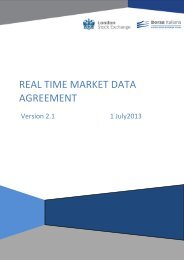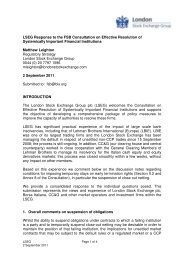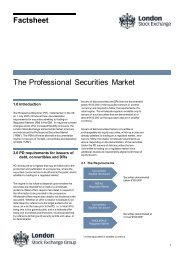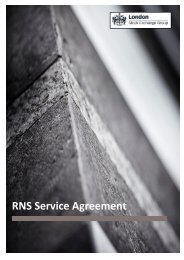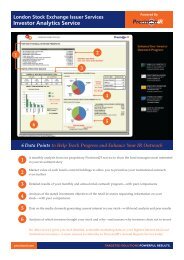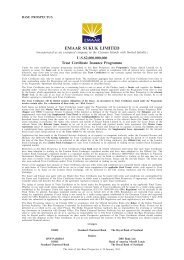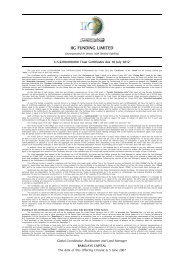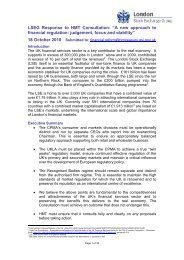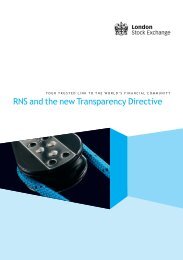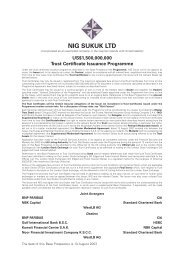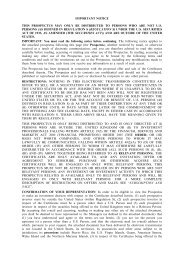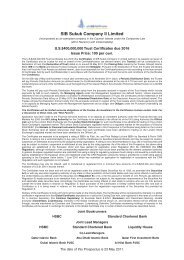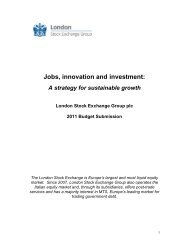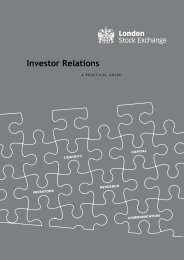Tabreed 06 Prospectus - London Stock Exchange
Tabreed 06 Prospectus - London Stock Exchange
Tabreed 06 Prospectus - London Stock Exchange
Create successful ePaper yourself
Turn your PDF publications into a flip-book with our unique Google optimized e-Paper software.
The growth of Dubai began in the early part of the 19th century when members of the Bani Yas<br />
tribe, led by Sheikh Maktoum Bin Butti, left Abu Dhabi and migrated north to found an<br />
independent Sheikhdom in the area now known as Dubai.<br />
As the 19th century unfolded, Dubai, split by a 14 kilometre long creek, which led into a natural<br />
harbour, established itself as a flourishing centre for the import and re-export of merchandise (the<br />
‘‘entrepôt trade’’). If entrepôt trade was the first and most important pillar of Dubai’s economic<br />
activity, the second was pearling. Offshore from Dubai and Abu Dhabi, the waters were rich with<br />
pearl beds. However, the Great Depression of the 1930s and the emergence of artificial pearls in 1929<br />
dented Dubai’s prosperity.<br />
To counter the loss of economic activity from the decline in pearling, Dubai enticed traders from<br />
India and Iran to establish their business. Traders, attracted by Dubai’s liberal policies, especially its<br />
lower taxes on foreigners compared to its neighbours, made it their base and Dubai was quickly<br />
established as a trading centre for trade in gold bullion, textiles and consumer durables.<br />
In the 1930s and 1940s, oil was discovered in Kuwait, Qatar and Saudi Arabia – adding to that<br />
already found in Iran, Iraq and Bahrain. In 1958, oil was found off the shore of Abu Dhabi and, in<br />
1966, oil was first discovered by the Dubai Petroleum Company at Fateh, which lies 92 kilometres off<br />
the coast of Dubai. As the primary regional trading hub, Dubai was well placed to capitalise on the<br />
upswing in Middle East business activity that came with oil exports. Over the years, oil revenues have<br />
been used to create and develop the economic and social infrastructure of Dubai.<br />
Dubai is, after the Emirate of Abu Dhabi, the largest emirate in the UAE, and is situated on the<br />
west coast of the UAE in the south western part of the Arabian Gulf. It covers an area of 3,885 sq.<br />
kilometres and lies approximately at longitude 55 degrees East and latitude 25 degrees North. Except<br />
for a tiny enclave in the Hajar Mountains at Hatta, the emirate of Dubai comprises one contiguous<br />
block of territory.<br />
Dubai’s strategic position at the crossroads between the East and West has helped establish it as a<br />
leading trading and services hub between the Far East and Europe.<br />
Dubai’s economy is more diversified and dynamic than that of Abu Dhabi and it is one of the most<br />
important commercial centres in the Middle East, with growing banking, tourism and real estate<br />
sectors. However, with only a fraction of the fossil fuel reserves of Abu Dhabi, it has gradually<br />
reduced its dependency on oil and gas revenues. The Government of Dubai continues to invest<br />
heavily in the infrastructure of the emirate and its economic development.<br />
All powers of government in Dubai are vested in the Ruler. The various departments and other arms<br />
of the government and their respective executives operate under the powers and responsibilities<br />
specifically delegated to them from time to time by the Ruler. Laws of Dubai are passed by decree of<br />
the Ruler. The present Ruler is H.H. General Sheikh Mohammed bin Rashid Al Maktoum, who is<br />
also chairman of Dubai’s Executive Council.<br />
In Dubai, there are various local government bodies charged with regulating and administering local<br />
law and policy, including the Dubai Department of Economic Development, Dubai Municipality and<br />
the Department of Civil Aviation.<br />
The population of Dubai was estimated at 1,204,000 at the end of 2003. There are no figures<br />
currently available for 2004 or 2005. Approximately 80 per cent. of the population is estimated to be<br />
non-UAE nationals, mainly drawn from the Indian subcontinent, Europe and other Arab countries.<br />
Approximately 70 per cent. of the population is estimated to be male and 30 per cent. female,<br />
reflecting the large male expatriate workforce.<br />
73



